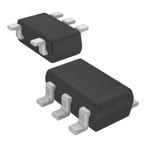Datasheet 搜索 > 放大器、缓冲器 > ADI(亚德诺) > ADA4610-1ARJZ-R7 数据手册 > ADA4610-1ARJZ-R7 产品设计参考手册 5/12 页

¥ 7.586
ADA4610-1ARJZ-R7 产品设计参考手册 - ADI(亚德诺)
制造商:
ADI(亚德诺)
分类:
放大器、缓冲器
封装:
SOT-23-5
Pictures:
3D模型
符号图
焊盘图
引脚图
产品图
页面导航:
应用领域在P8
导航目录
ADA4610-1ARJZ-R7数据手册
Page:
of 12 Go
若手册格式错乱,请下载阅览PDF原文件

Application Note AN-940
Rev. D | Page 5 of 12
FLICKER NOISE
The noise of op amps is Gaussian with constant spectral density
(white noise), over a wide range of frequencies. As frequency
decreases, the spectral density starts to rise because of the fabri-
cation process, the IC device layout, and the device type at a
rate of about 3 dB per octave for CMOS amplifiers, 3.5 dB to
4.5 dB per octave for bipolar amplifiers, or up to 5 dB per
octave for JFET amplifiers.
This low frequency noise characteristic is known as flicker
noise or 1/f noise because the noise power spectral density
goes inversely with frequency (1/f). It has a −1 slope on a log
plot. The frequency at which an extrapolated −3 dB per octave
(for a CMOS-type amplifier) spectral density line intersects the
broadband constant spectral density value is known as the 1/f
corner frequency and is a figure of merit for the amplifier (see
Figure 2). Bipolar and JFET amplifiers typically have lower 1/f
corner frequency than CMOS amplifiers.
100
10
1
0.1
0.1
10k1
VOLTAGE NOISE (nV/
√
Hz)
10 100
1k
FREQUENCY (Hz)
07053-005
EXTRAPOLATED 1/f
SPECTRAL NOISE DENSITY
EXTRAPOLATED
CONSTANT SPECTRAL
NOISE DENSITY
1/f CORNER FREQUENCY
Figure 2. Spectral Noise Density
POPCORN NOISE
Popcorn noise (not specified or advertised) is an abrupt shift in
offset voltage or current lasting for several milliseconds with
amplitude from several microvolts to hundreds of microvolts.
This burst or pop is random. Low temperatures and high source
resistances usually produce the most favorable conditions for
popcorn noise. Although the root cause of popcorn noise is
not absolute, both metallic contamination and internal or
surface defects in the silicon lattice can cause popcorn noise
in ICs. Although considerable work has been done to reduce
the sources of popcorn noise in modern wafer fabrication, it
cannot be eliminated. Further analysis of popcorn noise is
beyond the scope of this application note.
SUMMING THE NOISE SOURCES
If the noise sources are uncorrelated (that is, one noise signal
cannot be transformed into the other), the resulting noise is
not their arithmetic sum, but the square root of the sum of
their squares.
2
EX
nn
S
n
TOTALni
RV iReV )( ) ( )(
22
,
(5)
where:
V
ni, TOTAL
is the total noise referred-to-input (RTI).
e
n
is input-referred voltage noise.
i
n
is input-referred current noise.
R
S
is an equivalent source or input resistance to the amplifier.
V
n
(R
EX
) is voltage noise from external circuitry.
Note the following:
Any resistance in the noninverting input has Johnson noise
and converts current noise to a voltage noise.
Johnson noise in feedback resistors can be significant in
high resistance circuits.
Figure 3 visually shows the Equation 5 as the summation of
vectors by using the Pythagorean Theorem.
V
ni, TOTAL
e
n
R
S
×
i
n
V
n
(R
EX
)
07053-006
Figure 3. Vector Summation of Noise Sources
器件 Datasheet 文档搜索
AiEMA 数据库涵盖高达 72,405,303 个元件的数据手册,每天更新 5,000 多个 PDF 文件







